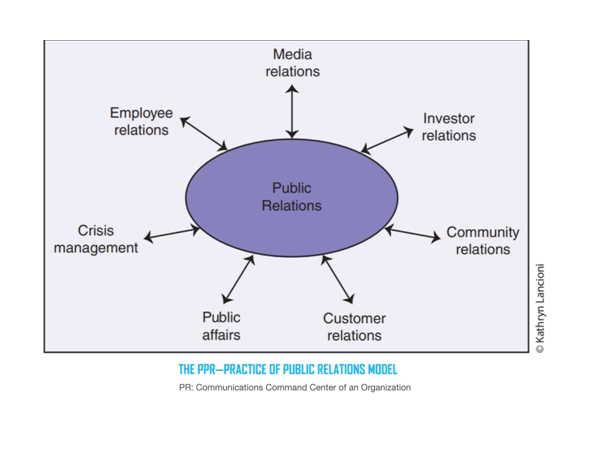Public Relations and the PPR Model
The idea of and concepts behind public relations are not new. The field of public relations dates back hundreds of years and has evolved from those early days to what it is today. Industry forefathers such As Edward Bernays, Ivy Ledbetter Lee and Arthur W. Page could never have imagined the critical role public relations would play in the contemporary business arena or how much it would evolve. An organization’s public relations department plays a vital role in supporting all facets of a company’s operations—ranging from the execution of its communication strategy to the achievement of its overall business objectives. The astounding reality is most people in an organization, especially those in the C-suite, have no appreciation for the art or practice of public relations. Many cannot even define the term public relations.
At the most basic level, the idea of public relations is quite simple. Essentially, the role of the public relations professional is to connect an organization to its external audiences or publics. This work is done through the execution of a variety of strategies and tactics selected specifically to address the needs of a company’s various publics. These techniques range from media relations and special events to social media posts and influencer campaigns. Some popular PR tactics include: news releases, contributed articles, press conferences, speaking engagements, webinars, special events, and community service programs. These and many other techniques will be explored in the subsequent chapters of this book.
The goals of most public relations programs include: creating, maintaining, and protecting the organization’s reputation, enhancing the value of its brand and presenting a positive image of the company. Many recent market research studies, including one specifically by Nielsen Research, show that consumers make purchase decisions based on a company’s reputation as reflected in the media suggesting public relations efforts can have a strong influence on a company’s sales and revenue.
Another goal for most public relations programs is to create and foster a sense of good will for the organization. This includes interfacing with such areas of an organization as employee relations, investor relations, media relations, community relations and public affairs. Public relations may also help to educate specific audiences or publics about issues relating to the organization including its: business model, vision and objectives, its CSR program and community policies, product line, crisis management programs and public affairs initiatives. For example, a nonprofit organization may use its PR team to educate the public relative to its position on a certain cause or point of view, while trade associations could implement educational programs relating to industries or policies they support.
PPR Model
In most organizations, the public relations department is the communications hub of the organization. Not only does it design and direct the organization’s proactive external communications efforts, but it determines and manages its overall communications strategy. This includes the important development of a company’s key communication messages and then the translation of the messages to each of the company’s audiences, including: investors, customers, suppliers, employees, local and state governments, community members and the media. The PR team also plays a significant role in the management of any crisis a company encounters. In the event of a crisis, PR professionals work directly with senior management to develop and implement the organization’s overall external response, as well as to each of its targeted publics.
As illustrated in the model below, the public relations department either directs or influences all of an organization’s proactive communication campaigns and reactive responses for an array of departments across an organization.

As noted in the diagram above, a public relations department is the communications command center guiding and monitoring the company’s overall communications efforts. The involves tracking both the company’s proactive external communication campaigns, as well as the reception and interpretation of these campaigns by targeted publics in the marketplace. Thus, it is a two-way, continually changing dynamic. This mandates “listening to the constituencies on which an organization depends, as well as analyzing and understanding the attitudes and behaviors of those audiences. Only then can an organization undertake an effective public relations campaign. (INC)” Clearly, the role of the public relations professional extends well beyond its defined responsibilities, into many other areas of an organization.
SUMMARY AND APPLICATION OF THE PPR MODEL
The PPR Model illustrates the role of the public relations department as the communications hub and control center of an organization. In coordination with the C-team, it is the central unit that develops and disseminates key messages to the organization and supports the translation of these messages to the various constituencies. In times of crisis or conflict, the PR team sets the strategy and works with other parts of the organization to implement it in the marketplace. There is no other team in the organization that has greater control of its communications program than the public relations department. In the subsequent chapters in this book, you will learn more about the public relations industry, the role of the public relations professional and the vital role the public relations team in supporting other parts of the organization.
REFERENCES
Coombs, Dr. W. Timothy, “Crisis Management and Communications.” The Institute for PR. 23 September 2014. Accessed 15 June 2020. https://instituteforpr.org/crisis-management-communications/
Hawin, Paige. “Public affairs vs. public relations: What is the difference?,” PR Daily, 19 December 2016. Accessed 15 June 2020. https://www.prdaily.com/public-affairs-vs-public-relations-what-is-the-difference/.
INC. “Public Realtions.” n.d., n.a.. Accessed 18 June 2020. https://www.inc.com/encyclopedia/public-relations.html
Juneja, Prachi. “Employee Relations – Importance and Ways of Improving Employee Relations,” Management Study Guide, n.d. Accessed 18 June 2020. https://www.managementstudyguide.com/employee-relations.htm

